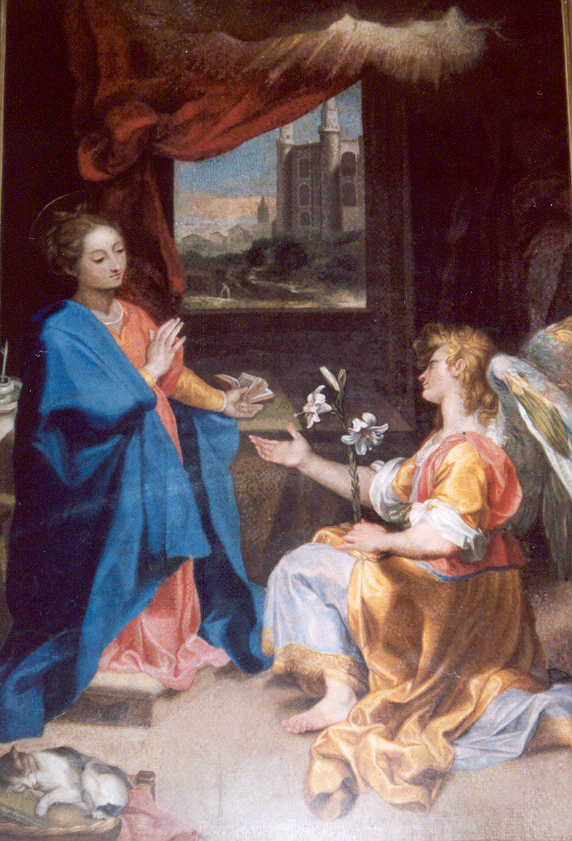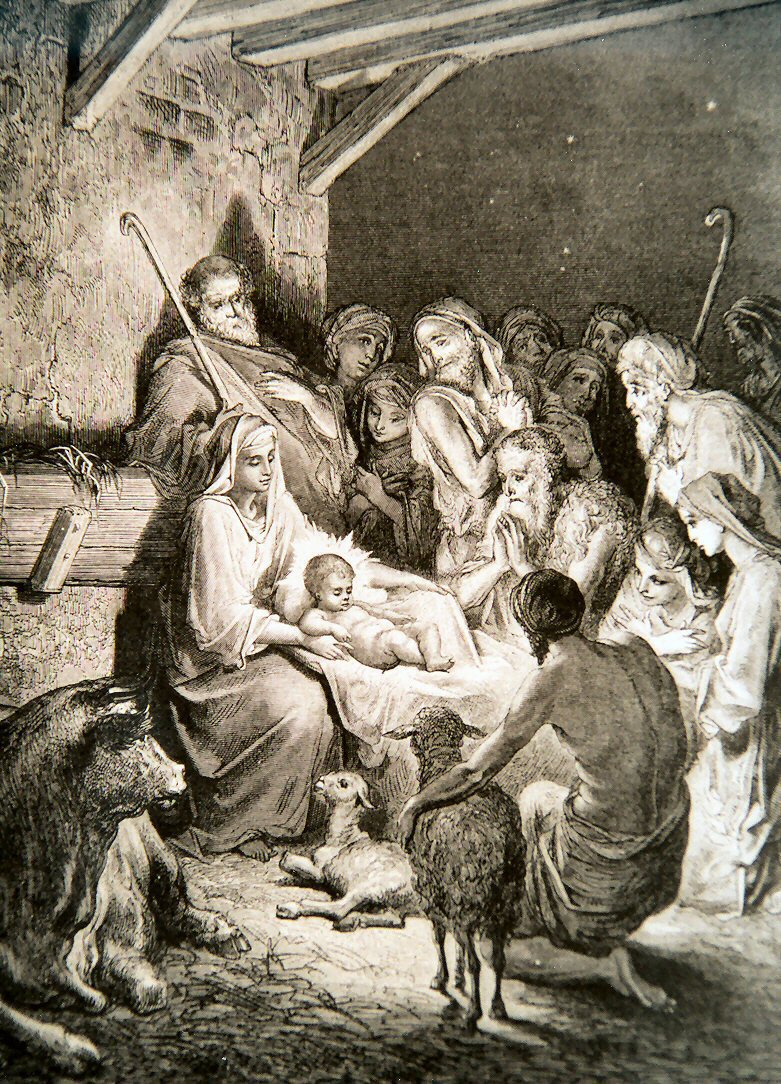
Our Lord and Savior Jesus Christ
Return to
Index The Catholic Faith
Return to
Level Three Topic Index
Home Page
God promised Adam and Eve that he would send a Redeemer, someone who would make up for original sin and the separation it caused between man and the Creator. Then God began his plan for our salvation by choosing a community of people, the Jews or Israelites, to whom he gradually revealed his plan. He sent prophets to these people to prepare them for the coming of the Messiah, the "Anointed One" of God.
The various prophets had told the Jewish people that the Messiah would indeed come to them, but they never said exactly who he would be. Most of the people expected a great and powerful military leader who would free them from political oppression. That this Savior would be God himself, come down to liberate them from their spiritual slavery to sin and the devil was not what they expected.
But the prophets did give the people some clues about the Messiah, ways to recognize him once he came. They said that he would be a member of the tribe of Judah (Gen 49:8-10); he would be born of a virgin (Is 7:14) in the town of Bethlehem (Micah 5:2-4). A great star would shine in the sky to announce the Messiah's birth (Num 24:17), and he would live for a time in Egypt (Hos 11:1-4). This Redeemer would preach God's good news to the poor and the lowly (Is 61:1-3), but he would be rejected by the people who would cause him much suffering (Is 53:1-12).
You probably recognize the life of the Lord Jesus in the above prophesies; many of the Jews did, and they accepted him as the Messiah sent from God. But many others did not.
The Incarnation of Our Lord

From among all the women of the chosen people, God selected one through whom he would fulfill his promise of salvation: the Virgin Mary of Nazareth. One day, he sent the angel Gabriel to her, saying: Hail, full of grace, the Lord is with you! Do not be afraid, Mary, for you have found favor with God. And behold, you will conceive in your womb and bear a son, and you shall call his name Jesus. He will be great, and will be called the Son of the Most High; and the Lord God will give him the throne of his father (ancestor) David, and he will reign over the house of Jacob for ever; and of his Kingdom there will be no end (Lk 1:28, 30-33).
Now Mary, as the Church has always taught, was a virgin, as her response to this angelic messenger reveals: "How can this be since I have no husband?" (Lk 1:34).
The angel told her that God, in his almighty power, would work this great wonder within her. By the power of the Holy Spirit the child would be conceived in her womb. Joseph, the man whom she was to marry, would seem to be the baby's father but he was actually the Lord's foster father and protector. Mary, ready to do whatever God asked of her, replied to the angel: "Behold, I am the handmaid of the Lord; let it be done to me according to your word" (Lk 1:38).
With these words Mary showed how dedicated she was to God's plan for her life and for our salvation. She called herself the "handmaid" of the Lord, which is another way of saying that she was God's servant or slave, ever ready to do whatever he asked of her.
As soon as Mary expressed her consent to God's will, Jesus was conceived in her womb. Nine months later he was born in the little town of Bethlehem, and his nativity (birth) was announced by the appearance of the miraculous star, just as had been foretold. We call this event, by which the Son of God took on our human nature, the Incarnation.
The Divinity of Jesus
The second person of the Blessed Trinity came down from Heaven in order to share our human life. Even more, he freely chose to be born in poverty and to live a poor life, so that we could learn that wealth and worldly pleasures do not give us true happiness. He became man so that we, by being freed from original sin and reunited with God by Baptism, could become like him, the children of the Father. Saint Irenaeus, a holy bishop of the second century, once said: "The Word of God, Jesus Christ, on account of his great love for mankind, became what we are in order to make us what he is himself."
For thirty years Jesus lived a normal human life with Mary and Joseph, working as a carpenter in the village of Nazareth. He did this in order to teach us that even such ordinary things as work and family life are very important to God. This first part of Christ's life is called his "hidden life", because during this time the people did not know who he really was and because we do not know very much about it.
When Our Lord was about thirty years old he began what is known as his "public life", that is, the three years he spent preaching, teaching, and working miracles. These miracles were signs and proofs of his divinity. They showed that he was truly the Son of God. A miracle is some event or happening that is beyond the powers of man or of nature. It can only be worked by God, who is the Lord and Master of all creation.
The public life of Jesus began with his baptism in the Jordan River by Saint John the Baptist. At this time, the evangelists (writers of the Gospels) tell us that the Holy Spirit came down upon Jesus and the Father's voice was heard to say: "This is my beloved Son with whom I am well pleased" (Mt 3:17).
This was the first time that Jesus of Nazareth was publicly revealed as the son of God. (Of course, Mary and Joseph already knew who he was). It was also the first time that the mystery of the Blessed Trinity was revealed. During his ministry Our Lord spoke of himself as the Son of God, saying: "I solemnly declare it: before Abraham came to be, I AM" (Jn 8:58), (Remember that "I AM" is the name God revealed to Moses in the burning bush).
So we see from all of these events recorded for us in the Gospels that Jesus Christ is both God and man at the same time! This is a great mystery of faith, but we accept it as true because God has revealed it to be so. We call this mystery the hypostatic union. This phrase comes from a Greek word which tells us that Our Lord is the son of God and the son of Mary, fully God with all of the divine powers, and fully man like us in everything except sin.
The Humanity of Jesus

Jesus had everything that makes someone a human being: a physical body with all of its various functions, an immortal soul with its powers of intellect and will. As a man he had to grow daily in acquiring human knowledge, and he experienced the joys and sorrows of life just as we do. The Gospels remind us that he felt hunger and thirst (Lk 4:2); he loved children (Mk 10:13-16); he knew sorrow and cried over the death of a friend (Jn 11:32-36); he experienced loneliness (Mt 26:37-46); he enjoyed friendship (Lk 19:1-10); felt joy and gladness (Lk 10:21); he went through suffering and death (the accounts of the Passion in all four Gospels).
Jesus was like us in all things except sin (Heb 4:15). This is because, as the second Person of the Blessed Trinity, he is all-holy. But this does not mean that Jesus was free from temptations to sin; the Gospels make it very clear that he was tempted just as we are (Mt 4:1; Mk 1:13; Lk 4:2-13). Since he was a human being like us, this means that we too can live free from sin, with the help of his grace which is always available to us through the sacraments. Jesus has made it possible for us to live a sinless life just as he did!
Errors about the Incarnation
Throughout the history of Christianity heresies, or errors, about the mystery of the Incarnation have been taught by various mistaken followers of the Lord. Heresies are very dangerous to the faith because they corrupt or destroy man's understanding of the truth which leads to salvation.
The first heresy to attack the truths taught by the Church happened in the days of the apostles of the Lord; it was called Docetism. It corrupted the truth that Jesus is human. This heresy said that Christ only seemed to be a man. Some people believed this because they viewed the human body as evil; so naturally, according to their way of thinking, God would not take on a real human body! The magisterium of the Church condemned these teaching of the Docetists as heresy, and Saint John wrote his Gospel partly to show that the Docetists were wrong. But this heresy lives on in our own day among those who think that the human body is sinful and not something which God created as good. It also affects those Christians who see Christ only as the Son of God, and not as a true, full human being.
Another terrible heresy sprang up among Christians in the beginning of the fourth century. It was started by a priest who denied the truth about Christ's divinity. The priest's name was Arius, and so his false teaching was called Arianism. Arians believed that Our Lord was the Messiah sent from God, that he was the greatest of teachers and holiest of men, but they would not believe that he was divine. An unfortunate thing about this heresy is that it attracted thousands of Christians, including many bishops! We can learn from this that even priests and bishops can be led astray from the Gospel if they do not remain united to the Pope, for at the time the Holy and a few faithful bishops were the only ones teaching the truth about Jesus' divinity. As you can well imagine, things got so out of hand that the first Ecumenical Council (meeting of all the bishops of the Church with the Pope) was held in order to condemn this false teaching officially. It was called the Council of Nicea (325 A.D.), and from this meeting we received the Nicene Creed, which we recite every Sunday at Holy Mass.
Unfortunately, Arianism can still be found today among those who call Christ a "great man" and "moral leader" but who refuse to acknowledge his full divinity. These people place Jesus on the same level as the founders of other religions (such as Buddha or Mohammed), and consider Christianity to be simply one religion among all the others. They fail to see that God has become man for them, for all of us, so that we can truly live with him on the earth and for ever in Heaven.
Used with the permission of The Ignatius Press 800-799-5534
Return to
Index The Catholic Faith
Return to
Level Three Topic Index
Top
Home Page